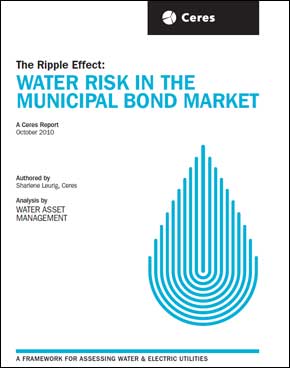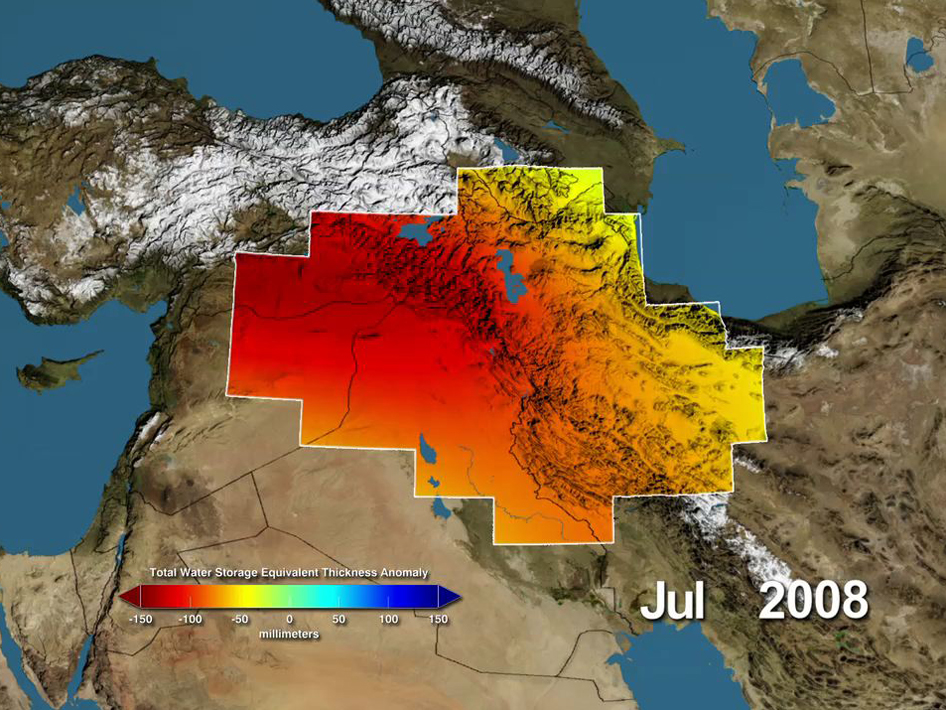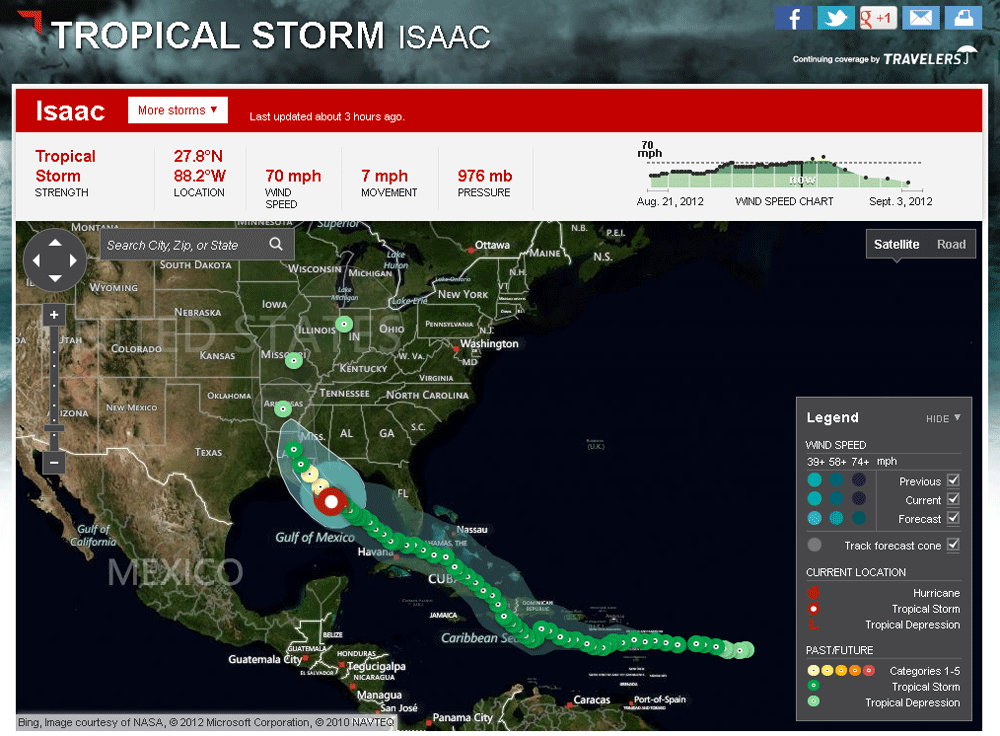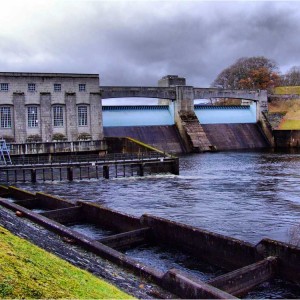Report Highlights Lack of Water Risk Disclosure in Municipal Bonds
The study identifies the need for major overhaul of how water risk is measured and reported in the U.S.
 Water scarcity, surging water demand, pollution and climate change put numerous constraints on municipal water and electric utilities in the United States, but these risks are poorly disclosed to investors who buy municipal bonds, according to a report released on Thursday.
Water scarcity, surging water demand, pollution and climate change put numerous constraints on municipal water and electric utilities in the United States, but these risks are poorly disclosed to investors who buy municipal bonds, according to a report released on Thursday.
The report by Ceres, a national coalition of investors and environmental groups, assesses the water risk to public utilities, investors and bond rating agencies.
“Investors who provide the capital and financing to build and maintain the nation’s vast water and power infrastructure are threatened by these water trends,” said Mindy Lubber, president of Ceres, at a press teleconference for the report’s release on Thursday.
The Ceres report is part of a growing recognition that water scarcity will affect everything from business supply chains to corporate investment portfolios, and that better information is needed about the risks. The Water Disclosure Project, an offshoot of the Carbon Disclosure Project, for example, is gathering commitments from the world’s largest corporations to voluntarily submit data on water risks in supply chains and company operations.
Public utilities are also coming under scrutiny from investors. Roughly 80 percent of Americans get their water from more than 53,000 municipal suppliers operating in the country, but public utilities are not subjected to the same stringent risk reporting standards as investor-owned utilities.
This uncertainty has the potential effect of driving away capital from municipal utilities, said Matthew Diserio, the president of Water Asset Management, an investment company that provided analysis for the Ceres report.
Investor-owned utilities are required by the Securities and Exchange Commission (SEC) to disclose material risks such as water scarcity in their annual 10-K filings. In February, the SEC issued new guidelines that clarify disclosures related to climate change risk, mentioning water scarcity as a concern.
State public utility commissions, which regulate investor-owned utilities, also require, to varying degrees, reporting on material risks.
“That is a benefit in terms of attracting capital to privately-owned water-related solutions,” Diserio said.
Other investment firms echoed his sentiments: “In recent years, investors such as ourselves have been asking, ‘How do we factor trends such as climate change and water scarcity into our investment decisions,’” said Bruce Kahn, senior investment analyst with Deutsche Asset Management. “While there’s growing information on equities and corporate debt, the potential impact to other asset classes such as municipal bonds has not been addressed at the same level of rigor.”
Bond agencies for the most part take a utility’s own assessment of availability as a given, thus rarely addressing the supply stresses, according Sharlene Leurig, who wrote the report and interviewed rating agencies in its preparation.
Leurig said that credit rating agencies do not rigorously account for water scarcity in their bond evaluations and may even contribute to wasteful water consumption by rewarding infrastructure development that encourages water use and revenue growth.
“The credit rating agencies said that, generally, they look at water availability when they assess water utilities, which is true,” Leurig said. “But what we need to remember and understand is when they assess water availability, they are looking at a future that looks just like the past.”
Fitch Rating, one of the major U.S. bond rating agencies, disagrees.
“Water supply risk has consistently and transparently factored into Fitch’s ratings and analysis of municipal bonds,” wrote Eric Friedland, group credit officer and managing director in Fitch Rating’s U.S. Public Finance group, in an email to Circle of Blue. “This risk is also highlighted in Fitch’s rating guidelines which can be found on our website.”
Ceres partnered with PricewaterhouseCoopers to develop a quantitative model of water risk, and used it to analyze six water utility bonds and two electric utility bonds representing utilities in water-stressed regions. The model compared water availability with projected demand up to 2030, using four climate scenarios and multiple “stress tests” to determine resiliency to sharp fluctuations in supply.
The group found that the Los Angeles Department of Water and Power had the highest risk score, followed by Atlanta’s Water and Sewer System. The former relies on water imports from vulnerable watersheds, and Atlanta is facing a federal judicial order that could cut its water supply by 40 percent in 2012.
However, whole regions should not be disregarded as good investments offhand. Neighboring water utilities in Tarrant County, Texas, and Dallas received different scores, underlining the effects of a utility’s water management plan on its water risk. A utility with low prices or low debt can raise prices to curb demand or raise financing for infrastructure improvements easier than a utility held back by a high debt load.
According to the report, water shortages can hurt the value of a municipal bond by affecting the utility’s ability to make timely payments and by reducing the bond’s price in resale markets. Long-term water shortages could create a “vicious cycle of credit stress,” in which a utility relies ever-increasing rate adjustments and higher-cost bond issues to keep up with debt payments and infrastructure improvements.
As Circle of Blue has reported in its Choke Point: U.S. series, water shortages also affect electric utilities. Power plants may be barred from withdrawing from rivers if the water level is so low that warmer return flows from the plant threaten aquatic life. Such was the case for power plants in the Southeast during a drought in 2007.
Hydropower also needs a sufficient volume of water in reservoirs to generate electricity, a concern in the Southwest, as falling water levels in Lake Mead threaten to shut down the Hoover Dam.
“The report demonstrates that ample, long-term water supplies are not a guarantee and that in many parts of the country, they are in serious question,” Lubber said.
Brett writes about agriculture, energy, infrastructure, and the politics and economics of water in the United States. He also writes the Federal Water Tap, Circle of Blue’s weekly digest of U.S. government water news. He is the winner of two Society of Environmental Journalists reporting awards, one of the top honors in American environmental journalism: first place for explanatory reporting for a series on septic system pollution in the United States(2016) and third place for beat reporting in a small market (2014). He received the Sierra Club’s Distinguished Service Award in 2018. Brett lives in Seattle, where he hikes the mountains and bakes pies. Contact Brett Walton












Leave a Reply
Want to join the discussion?Feel free to contribute!